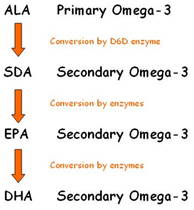Q8. What is the remedy?
Ans. This is a serious but remediable public health problem. For this there has to be two pronged attack on the problem for correcting the imbalance of omega-3 and omega-6 and bring down avoidable excessive inflammation and at the same time increase the intake of omega-3 fatty acids.
Q9. Why has omega-3 fatty acids become an endangered nutrient?
Ans. Man as hunter-gatherer not too long ago in man’s history on this planet, was consuming less fat and almost equal amount of omega-6 and omega-3 fat. Omega-3 fatty acids are very unstable and have very low shelf life and in the modern world of the civilized society of packed food, omega-3 fatty is unwanted and avoided by food industry.
Q10. What is the role of omega 3 fatty acids in human body?
Ans. As mentioned above ALA is the primary, essential omega-3 fatty acid. From ALA, other omega-3 fatty acids, Eicosapentanoic acid (20 carbon EPA) and Decosahexanoic acid (22 carbon DHA) can be derived in human body.
From EPA several twenty carbon anti-inflammatory fatty acids (eicosanoids) thromboxanes, leucotriens, prostagalndins and some lipid mediators are derived, and these EPA derived molecules regulate thousands of functions in human body. DHA is structural and functional constituent of membrane, brain, eye and testes.
Q11. What are the good dietary sources of omega-3 fatty acids?
Ans. Flaxseed (also called linseed) is the richest vegetarian source of ALA. Fish oil has EPA and DHA. Algae can provide DHA.
Q12. Are ALA, EPA and DHA equal in their action?
Ans. The importance of omega-3 fatty acids for human health was first established with the observation that eskimos (now called inuits) in Greenland surviving only on fatty fishes (rich in EPA and DHA) and consuming very little of carbohydrates, are protected from heart attack. As fish oil directly provided the physiologically functional fatty acid EPA and DHA, the cardio-protective nature of EPA and DHA was established in rest of the population also.
Q13. What about the vegetarians who are getting only ALA?
Ans. As mentioned above ALA is the primary essential fatty acid. It is the only form of fatty acid available to vegetarians. Obviously ALA, must meet the EPA and DHA requirements of vegetarians adequately. EPA and DHA being immediately physiologically active seems more potent. However consumption of EPA and DHA in the diet reduces the ability of conversion of ALA to EPA and DHA. Eskimos adapting to fatty fish have lost their ability to utilize ALA. ALA can further suppress the inflammatory effect of LA by inhibiting the formation of arachidonic acid (20 carbon inflammatory eicosonoids).
Q14. How does EPA help to maintain good health?
- EPA:
- Maintains normal platelet stickiness. High platelet stickiness is the first stage of clot formation which can lead to heart attacks, strokes, phlebitis and pulmonary embolism,
- Maintains arterial muscle tone, regulates blood pressure,
- Controls the inflammatory response provides relief in arthritis and psoriasis.
- Regulates sodium excretion, thereby controls water retention and provides relief in Post-Menopausal syndrome and overweight.
- Regulates immune function, provides relief in virus infections, cancer, AIDS and allergies.
Q15. What is the role of Flaxseed (linseed) oil -ALA Omega-3’s in our body?
Ans. As mentioned earlier ALA is the primary essential omega-3 fatty acid. ALA gets converted to EPA and DHA in a controlled manner wherever needed in the body and in quantities needed. Women need more EPA and DHA particularly during pregnancy and they have better ability to convert ALA to EPA and DHA. ALA further can suppress LA to AA conversion, a function, EPA and DHA in fish oil cannot perform.
Q16. What are the limitations of Fish oil?
Ans. Vegetarians cannot consume fish and fish oil. Fish oil has very high amounts of mercury contamination. Fish source is fast dwindling. From fish oil you get EPA and DHA directly and that diminishes the body’s ability to convert ALA to EPA and DHA.
